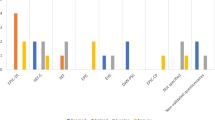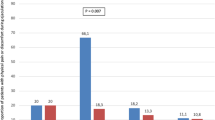Abstract
The core question of the study was whether the nerve-sparing status and surgical approach affected the patients’ sexual life in the first year after surgery. In addition, determinants of erectile function (EF) and the extent of sexual activity were investigated. We conducted a multicentric, longitudinal study in seven German hospitals before, 3, 6 and 12 months after radical prostatectomy (RP). A total of 329 patients were asked to self-assess the symptoms associated with erectile dysfunction (ED). These symptoms were assessed using the International Index of Erectile Function and EORTC QLQ-PR25 questionnaires. A multiple regression model was used to test the influence of clinical, socio-demographic and quality-of-life-associated variables on the patients’ EF 1 year after RP. Before surgery, 39% of patients had a severe ED (complete impotence). At 3, 6 and 12 months after surgery, it was 80, 79 and 71%, respectively. Although the surgical approach had no significant effect on EF, patients who had undergone nerve-sparing surgery had significantly lower ED rates. Nevertheless, 1 year after RP, 66% of these patients had severe ED. Age, nerve-sparing status and the burden of urinary symptoms had the greatest impact on the patients’ EF. Regardless of nerve-sparing status and surgical approach, postsurgical improvement of EF does not mean a full convalescence of presurgical EF. Instead, it may rather reduce the degree of postsurgical ED in time. Consequently, urologists should disclose to the patient that ED is a likely side effect of RP.
This is a preview of subscription content, access via your institution
Access options
Subscribe to this journal
Receive 8 print issues and online access
$259.00 per year
only $32.38 per issue
Buy this article
- Purchase on Springer Link
- Instant access to full article PDF
Prices may be subject to local taxes which are calculated during checkout


Similar content being viewed by others
References
Robert-Koch-Institut. Cancer in Germany 2005/2006. Incidence and Trends. Robert-Koch-Institut: Berlin, 2010.
Robert-Koch-Institut. Prostate Diseases Issue 36. Robert-Koch-Institut: Berlin 2007.
Jemal A, Siegel R, Ward E, Hao YP, Xu JQ, Thun MJ . Cancer statistics 2009. CA Cancer J Clin 2009; 59: 225–249.
Parker SL, Tong T, Bolden S, Wingo PA . Cancer statistics 1997. CA Cancer J Clin 1997; 47: 5–27.
Papadoukakis S, Kusche D, Stolzenburg JU, Truss MC . Reconsidering the use of the International Index of Erectile Function questionnaire in evaluating the preoperative erectile function status of patients undergoing radical prostatectomy. BJU Int 2007; 100: 368–370.
Capoun O, Hanus T, Babjuk M, Dvoracek J, Pavlik I, Novak K . Erectile dysfunction in patients after radical prostatectomy. Eur Urol Suppl 2010; 9: S641, (abstract C87).
Penson DF, McLerron D, Feng ZD, Li L, Akerley W, Albertsen PC et al. Five-year urinary and sexual outcomes after radical prostatectomy: results from the prostate cancer outcomes study. J Urol 2005; 173: 1701–1705.
Romero-Otero J, Touijer K, Guillonneau B . Laparoscopic radical prostatectomy: contemporary comparison with open surgery. Urol Oncol 2007; 25: 499–504.
Ayyathurai R, Manoharan M, Nieder AM, Kava B, Soloway MS . Factors affecting erectile function after radical retropubic prostatectomy: results from 1620 consecutive patients. BJU Int 2008; 101: 833–836.
Kundu SD, Roehl KA, Eggener SE, Antenor JAV, Han M, Catalona WJ . Potency, continence and complications in 3477 consecutive radical retropubic prostatectomies. J Urol 2004; 172: 2227–2231.
Stolzenburg JU, Rabenalt R, Do M, Ho K, Dorschner W, Waldkirch E et al. Endoscopic extraperitoneal radical prostatectomy: oncological and functional results after 700 procedures. J Urol 2005; 174: 1271–1275.
Wiltink J, Hauck EW, Phädayanon M, Weidner W, Beutel ME . Validation of the German version of the International Index of Erectile Function (IIEF) in patients with erectile dysfunction, Peyronie's disease and controls. Int J Impot Res 2003; 15: 192–197.
Rosen RC, Riley A, Wagner G, Osterloh IH, Kirkpatrick J, Mishra A . The international index of erectile function (IIEF): a multidimensional scale for assessment of erectile dysfunction. Urology 1997; 49: 822–830.
Cappelleri JC, Rosen RC, Smith MD, Mishra A, Osterloh IH . Diagnostic evaluation of the erectile function domain of the international index of erectile function. Urology 1999; 54: 346–351.
Van Andel G, Bottomley A, Fossa SD, Efficace F, Coens C, Guerif S et al. An international field study of the EORTC QLQ-PR25: a questionnaire for assessing the health-related quality of life of patients with prostate cancer. Eur J Cancer 2008; 44: 2418–2424.
Zigmond AS, Snaith RP . The hospital anxiety and depression scale. Acta Psychiatr Scand 1983; 67: 361–370.
Beutel ME, Weidner W, Brahler E . Epidemiology of sexual dysfunction in the male population. Andrologia 2006; 38: 115–121.
McKinlay J . The worldwide prevalence and epidemiology of erectile dysfunction. Int J Impot Res 2000; 12: 6–11.
Briganti A, Capitanio U, Chun FKH, Karakiewicz PI, Salonia A, Bianchi M et al. Prediction of sexual function after radical prostatectomy. Cancer 2009; 115: 3150–3159.
Kaul S, Savera A, Badani K, Fumo M, Bhandari A, Menon M . Functional outcomes and oncological efficacy of Vattikuti institute prostatectomy with Veil of Aphrodite nerve-sparing: an analysis of 154 consecutive patients. BJU Int 2006; 97: 467–472.
Michl UH, Friedrich MG, Graefen M, Haese A, Heinzer H, Huland H . Prediction of postoperative sexual function after nerve sparing radical retropubic prostatectomy. J Urol 2006; 176: 227–231.
Schover LR, Fouladi RT, Warneke CL, Neese L, Klein EA, Zippe C et al. Defining sexual outcomes after treatment for localized prostate carcinoma. Cancer 2002; 95: 1773–1785.
Anastasiadis AG, Salomon L, Katz R, Hoznek A, Chopin D, Abbou CC . Radical retropubic versus laparoscopic prostatectomy: a prospective comparison of functional outcome. Urology 2003; 62: 292–297.
Montorsi F, Briganti A, Salonia A, Rigatti P, Burnett AL . Current and future strategies for preventing and managing erectile dysfunction following radical prostatectomy. Eur Urol 2004; 45: 123–133.
McCullough AR . Sexual dysfunction after radical prostatectomy. Rev Urol 2005; 7: 2–10.
Acknowledgements
The study was sponsored by the German Cancer Aid (Deutsche Krebshilfe e.V.).
Author information
Authors and Affiliations
Corresponding author
Ethics declarations
Competing interests
The authors declare no conflict of interest.
Rights and permissions
About this article
Cite this article
Koehler, N., Holze, S., Gansera, L. et al. Erectile dysfunction after radical prostatectomy: the impact of nerve-sparing status and surgical approach. Int J Impot Res 24, 155–160 (2012). https://doi.org/10.1038/ijir.2012.8
Received:
Revised:
Accepted:
Published:
Issue Date:
DOI: https://doi.org/10.1038/ijir.2012.8
Keywords
This article is cited by
-
Indications and characteristics of penile traction and vacuum erection devices
Nature Reviews Urology (2022)
-
Inside-out autologous vein grafts fail to restore erectile function in a rat model of cavernous nerve crush injury after nerve-sparing prostatectomy
International Journal of Impotence Research (2015)



